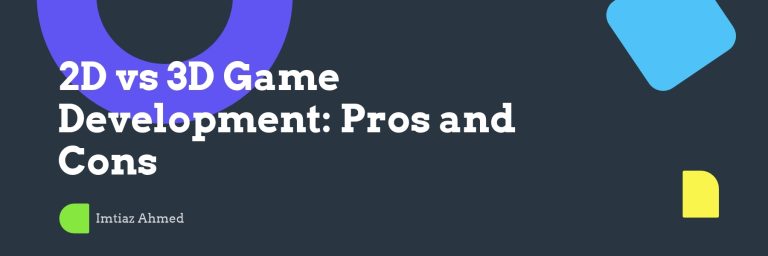Key Takeaways
Choosing the right dimensionality for your next game shapes every facet of its journey—from budgeting and talent allocation to marketing strategy and player retention. Below are the most critical insights that weigh the strengths and limitations of 2D and 3D game development, empowering new developers to make a data‑driven decision.
- 2D Wins on Profit: Simplicity Drives Margins—Because 2D titles require fewer assets, lighter pipelines, and lower tooling costs, they often deliver higher profit margins. Indie successes like Hollow Knight and Celeste illustrate how a lean budget can translate into 60 %+ gross margins.
- 3D Captures Immersive Storytelling—Rich, three‑dimensional worlds enable dynamic camera work, volumetric lighting, and realistic physics that deepen narrative immersion, a capability that 2D can only approximate with stylized art.
- 2D Cuts Development Time—Asset creation, animation, and level design are typically 30–50 % faster in 2D, allowing teams to iterate quickly, launch earlier, and respond to market feedback.
- 3D Demands Advanced Technical Skill—Realistic shaders, complex physics engines, and high‑fidelity lighting require specialized expertise and larger teams, often extending the learning curve and development timeline.
- 2D Offers Broad Platform Flexibility—Because 2D assets are lightweight, games run smoothly on a wide spectrum of devices, from low‑end smartphones to high‑end PCs, expanding audience reach.
- 3D Elevates Visual Appeal—High‑definition graphics, particle effects, and realistic textures attract players who expect cutting‑edge visuals and can justify premium pricing or subscription models.
- 2D Encourages Creative Art Styles—Stylized sprites and hand‑drawn backgrounds provide unique artistic expression without massive resource investment, fostering brand differentiation.
- 3D Enhances Multiplayer Dynamics—Complex 3D environments support large‑scale multiplayer experiences with realistic spatial interactions, as seen in titles like Fortnite and Destiny 2.
- Cost vs. Return: 2D is Lean, 3D is Heavy—While 3D projects can command higher sales prices, their higher upfront costs can erode profitability if not carefully managed, especially for mid‑tier studios.
- Decision‑Driven Development: Match Scope to Skill—Align the game’s dimensionality with your team’s expertise and the target audience’s expectations to maximize success and mitigate risk.
Armed with these insights, you can now dive deeper into each dimension’s nuances and chart a clear path forward for your game development project.
Introduction
Did you know that the majority of indie hits are 2D, yet the buzz around 3D keeps escalating? Choosing between 2D and 3D games is more than a visual preference—it’s a strategic move that can dictate your project’s budget, timeline, and market reach. For a new developer, grasping how each dimension impacts cost, speed, and audience can save months of trial and error and protect profit margins. The right choice shapes asset pipelines, platform compatibility, and ultimately the game’s success.
Let’s break down the pros and cons of 2D vs 3D games, comparing 2D game development with 3D game design, so you can align your team’s skills and target audience with the optimal game dimension.
Choosing Between 2D and 3D Game Development
Factors that influence the decision include budget, team skill set, target audience, platform reach, and desired gameplay experience.
What Drives the Decision
- Budget constraints and expected ROI
- Team expertise in 2D or 3D pipelines
- Target platforms and device capabilities
- Desired level of immersion and storytelling
- Long‑term maintenance and scalability
When evaluating these drivers, developers should weigh how each dimension aligns with their strategic goals. For instance, a small studio with a tight budget may prioritize rapid iteration and broad device compatibility, whereas a AAA publisher may seek the visual depth that only 3D can provide. A balanced approach often involves creating a hybrid strategy—leveraging 2D for core gameplay while incorporating 3D elements for cinematic sequences or multiplayer arenas.
2D Game Development
2D development offers simplicity, speed, and broad platform compatibility, making it attractive for indie studios and mobile titles.
Pros
- Lower production costs and higher profit margins
- Faster asset creation, animation, and level design
- Runs smoothly on a wide range of devices, from phones to PCs
- Encourages unique, stylized art styles without large budgets
- Quicker iteration cycles and faster market entry
Lower production costs stem from fewer required assets and less complex tooling. Indie successes like Hollow Knight and Celeste illustrate how 2D game development can deliver high revenue while keeping expenses modest—often yielding profit margins above 60 %. Faster asset pipelines mean a 20 % efficiency gain in production can translate into $5 M in annual savings for a mid‑size studio. Additionally, 2D titles typically launch on iOS, Android, PC, and web browsers with minimal optimization, expanding market reach. In education, 2D interactive simulations can be deployed on low‑spec devices in classrooms worldwide, demonstrating the versatility of the medium beyond entertainment.
Cons
- Limited immersive storytelling compared to 3D
- Less visual depth and dynamic camera angles
- Potentially lower visual appeal for premium pricing
- May not support large‑scale multiplayer dynamics as effectively
While 2D games can still convey rich narratives—think of the atmospheric storytelling in Ori & the Blind Forest—the absence of true depth can reduce immersion for players accustomed to 3D worlds. Dynamic camera work and volumetric lighting are harder to emulate, which may limit the perceived value of a premium price tag. Multiplayer scalability can also be constrained, as networked physics and large player counts often rely on 3D spatial calculations. Nevertheless, 2D platforms excel in genres like puzzle, platformer, and rhythm games, where clarity and speed of response are paramount.
3D Game Design
3D development delivers immersive worlds and high‑definition visuals, appealing to players seeking realism and depth.
Pros
- Immersive storytelling with dynamic camera angles
- High‑definition graphics and particle effects attract premium audiences
- Supports large‑scale multiplayer and complex environments
- Enhanced visual appeal can justify higher price points
The ability to craft expansive, photorealistic environments—such as in The Last of Us Part II—provides a compelling narrative canvas that 2D cannot match. High‑definition graphics, coupled with advanced particle systems, enable developers to create visually stunning experiences that resonate with players willing to pay a premium. Moreover, 3D game design naturally accommodates complex multiplayer mechanics, as seen in titles like Fortnite, where spatial interactions and physics are integral to gameplay. In architecture and engineering, 3D visualizations allow clients to explore virtual prototypes before construction, illustrating the cross‑industry value of immersive rendering.
Cons
- Higher upfront costs and larger teams required
- Steeper technical learning curve for physics, shaders, and lighting
- Longer development time for asset creation and level design
- Reduced platform flexibility; may need more powerful hardware
The initial investment in tools, middleware, and talent can be substantial—often exceeding $1 million for a mid‑tier AAA title. The technical complexity of shaders, physics engines, and lighting systems demands specialized expertise, extending the learning curve and development timeline. Production cycles can stretch from 12 to 24 months, delaying revenue streams. Finally, 3D games generally require more powerful hardware, limiting reach on entry‑level mobile devices and older PCs. However, emerging cloud gaming services and low‑poly mobile engines are gradually mitigating these barriers, opening new avenues for 3D experiences on a broader device spectrum.
Comparing Key Dimensions
Side‑by‑side comparison of critical factors to aid decision making.
Cost vs. Return
- 2D: Lean budgets, quick ROI
- 3D: Higher costs, potential for higher sales but riskier
In a cost comparison 2D vs 3D games, 2D titles often achieve a quicker return on investment—typically within 6 months—while 3D games may take 12–18 months before breakeven, even if they capture a larger market share. The higher profit margins of 2D games are a key advantage for studios with limited capital, whereas 3D projects can leverage brand prestige and franchise potential to offset the heavier investment.
Development Time
- 2D: Faster iterations
- 3D: Longer pipeline
Rapid prototyping is a hallmark of 2D game development. A single level can be built and tweaked in days, whereas a comparable 3D level may require weeks of modeling, texturing, and lighting work. In practice, a 2D prototype can validate core gameplay mechanics within a month, while a 3D proof‑of‑concept may take 2–3 months to reach a comparable level of polish.
Platform Reach
- 2D: Wide device compatibility
- 3D: Limited to higher‑end devices
Because 2D assets are less demanding, they run smoothly on smartphones, tablets, and low‑spec PCs, maximizing audience reach. 3D games, by contrast, often necessitate GPUs capable of rendering complex scenes, narrowing the target demographic. However, cloud‑based streaming services are gradually bridging this gap, allowing high‑fidelity 3D titles to be enjoyed on modest hardware.
Artistic Flexibility
- 2D: Stylized, hand‑drawn possibilities
- 3D: Realistic models and textures
Artists can experiment freely with pixel art, hand‑painted textures, and stylized shading in 2D, while 3D design offers photorealistic rendering that appeals to players seeking lifelike visuals. Hybrid approaches—such as 2.5D side‑scrollers with 3D character models—allow studios to blend the best of both worlds, creating distinctive visual identities.
Decision‑Driven Development: Match Scope to Skill
Practical framework for new developers to align game dimensionality with team strengths and audience expectations.
Match Scope to Skill
- Assess team expertise in 2D/3D pipelines
- Consider learning curve and time to proficiency
Begin by inventorying your team’s experience. If your artists excel at sprite animation and your programmers are comfortable with 2D physics engines, a 2D project may deliver faster results. Conversely, if your team includes seasoned 3D modelers and shader programmers, a 3D venture could leverage those strengths. Cross‑training can also reduce risk—having a small core of 3D specialists who mentor a larger 2D crew can create a versatile skill set that adapts to market shifts.
Audience Expectations
- Identify target platform and device capabilities
- Align visual and gameplay expectations
Survey your target demographic. Mobile gamers often favor polished 2D experiences that load quickly, whereas console audiences may anticipate immersive 3D worlds with rich storytelling. In education, interactive 3D simulations may be more engaging for STEM curricula, while 2D visualizations can be preferable for quick reference tools in business training.
Budget Planning
- Estimate production and maintenance costs
- Forecast potential revenue and profit margins
Use a detailed cost model that includes asset creation, engine licensing, and ongoing server support. For 2D titles, the maintenance window is typically shorter, allowing for more predictable long‑term revenue streams. In contrast, 3D games may require continuous content updates, DLC, or live‑ops to sustain player engagement, adding recurring costs that must be factored into the financial plan.
Prototype and Test
- Build quick prototypes in both dimensions
- Gather feedback and iterate
Rapid prototyping enables you to validate core gameplay mechanics before committing to a full production cycle. A small 2D prototype can reveal whether your game’s core loop resonates with players, while a 3D proof‑of‑concept can highlight technical feasibility and visual fidelity. User testing sessions, A/B experiments, and analytics dashboards provide objective data to guide the final dimensional choice.
Conclusion
Choosing between 2D and 3D hinges on a studio’s budget, skill set, and audience expectations. 2D shines with lower costs, rapid iteration, and broad device reach—ideal for indie teams and mobile titles—while 3D offers immersive storytelling and high‑end visuals that can justify premium pricing but demand larger teams and longer pipelines. Matching scope to talent, testing prototypes, and aligning platform reach with player habits are the decisive steps. Ultimately, the right dimensionality is the one that delivers the promised experience within your financial and timeline constraints.
Looking ahead, the convergence of procedural generation, AI‑assisted asset creation, and cloud gaming is eroding some of the traditional barriers between 2D and 3D. Studios that embrace adaptable pipelines, cross‑disciplinary collaboration, and data‑driven iteration will not only choose the correct dimension—they will shape it. The real question, therefore, isn’t whether you’ll adopt 2D or 3D, but how effectively you’ll leverage emerging tools and market insights to turn your vision into a profitable, engaging reality. The next wave of success will belong to those who can anticipate change, iterate relentlessly, and deliver experiences that resonate across platforms, genres, and audiences.





